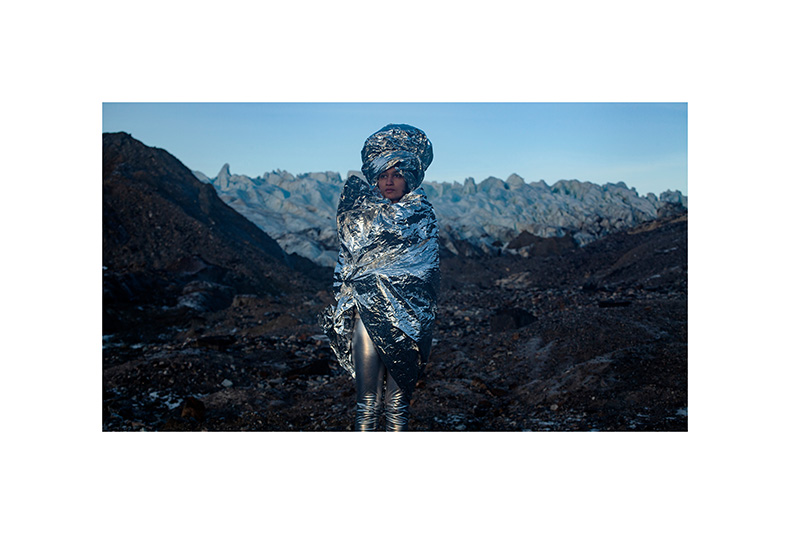Based in London and Delhi, the artist Himali Singh Soin creates elaborate fictional worlds – conjured through video, performance, textiles and poetry – that reflect a variety of real-world concerns, ranging from the climate crisis to the amorphous nature of identity in the postcolonial era. Her work often takes its cues from extended periods of field work in remote areas of the globe, drawing on the rituals and folklore that she finds there. ‘The Third Pole’, her current exhibition at Museo Nacional Thyssen-Bornemisza in Madrid, comprises two audio-visual installations made collaboratively with her partner, the musician David Soin Tappeser, which take the viewer on a journey from the uninhabited parts of the Arctic and Antarctic circles to the Himalayas.
Where is your studio?
In North London, between Dalston and Islington. It’s a long space, on the first floor and three of its sides are windows. I call it my observatory, but a lot of people who come to visit say that it feels like a ship, which I love because I would say that my other studio is an actual ship. All of the voyages I make, from the polar circles to the Caribbean to the volcanoes of Italy, are made by boat. This journey from water to land is quite important for me.
What do you like most about the space?
I love the windows. The character in my performance work quite often wears a silver space suit, which absorbs heat and reflects the landscape back. In a way, I feel like that’s what my studio does: it keeps the heat in but I can see out into the world.

we are opposite like that (film still; 2019), from Himali Singh Soin’s ongoing project of the same name (2017–present)
Do you work alone?
My partner David [Soin Tappeser], who makes the sound for all of my work, shares the studio with me for half the day. He goes to his own music studio in the morning and then when he comes here, we discuss ideas and talk about the logistical production stuff we have to do. There are lots of percussion instruments in the studio, so he will often play those while I work on poetry.
In India, an open studio means that people can (and do) drift in and out. I even post on my Instagram if I’m feeling social and put out an open invitation for anyone to drop by – it’s amazing how many people do.

Photo: courtesy Himali Singh Soin
How messy is it?
Not really at all. It gets messy on the days that we are cutting up fabrics or making something, or there might be books scattered about on a research day, but [the mess] never lasts more than a day. I can’t start fresh the next morning unless the space is clean.
Do you keep relics from your past projects?
Yes. There is sand from the Atacama desert and rocks from the Arctic and the Antarctic. There are 3D prints of comets and asteroids and fossils. A bunch of silver and golden space blankets, and lots of ceramics, which I’ve been making lately. The rocks are like my crystals – I feel like they hold and emanate stories; I am kind of superstitious about them. But when I look at these objects, I don’t necessarily remember the work that they correspond to. I feel like all of my work morphs into one.

we are opposite like that (film still; 2019), from Himali Singh Soin’s ongoing project of the same name (2017–present)
What are you currently reading?
I am reading A Short Philosophy of Birds. David and I just wrote a bird opera together, for which we had to spend a lot of time researching and chasing a bird called an Arctic tern. I found it first in Antarctica – we followed it to the Caribbean and then to Wales. This bird makes one of the biggest migrations of any species, and although the opera is now finished, I am still thinking a lot about birds. I also have another book on the go by Emily Ogden called On Not Knowing: How to Love and Other Essays.
Which artistic tool could you least do without?
I have many tools of measurement: a measuring tape, one of those really long rulers that opens out like an accordion, kitchen scales… I don’t use or even know how to use half of these tools of measurement but I like having them around me. I think I am attracted to the headache of it – all these lines and marks that I find somehow hubristic and comedic. I am four feet tall and David is seven feet and he often jokes that I have no sense of scale.
‘The Third Pole’ is at Museo Nacional Thyssen-Bornemisza, Madrid until 29 January 2023.














![Masterpiece [Re]discovery 2022. Photo: Ben Fisher Photography, courtesy of Masterpiece London](http://zephr.apollo-magazine.com/wp-content/uploads/2022/07/MPL2022_4263.jpg)
‘Like landscape, his objects seem to breathe’: Gordon Baldwin (1932–2025)